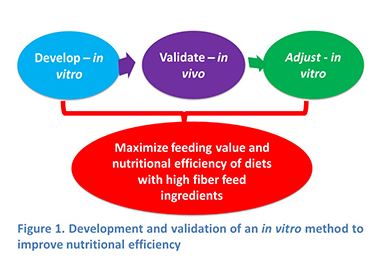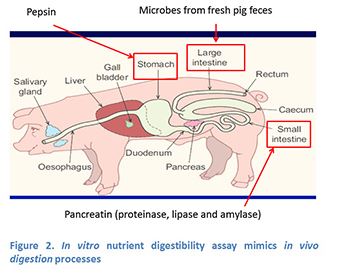



Transforming how we think about fiber
Fiber nutrition can reduce feed costs but a strategy is neededFiber nutrition is still in its infancy compared with the current depth of knowledge in amino acids and certain vitamins and minerals. There is increasing interest in the use of high-fiber ingredients due to their perceived benefits on gut health. Significant advancements in carbohydrate analysis has enabled diet formulators to increase use of fibrous ingredients in their rations, typically to ameliorate postweaning diarrhea, induce satiety, or improve feed costs. While some high-fiber ingredients may help reduce diet costs, others may not be cost effective in certain situations. We need to transform the way we think about fiber and the strategy we use to measure its success as a nutritional intervention.
Fiber refers to complex carbohydrate structures that are resistant to endogenous mammalian enzymes. Dietary fiber can be broken down by enzymes expressed by microbiota inhabiting the gut, subsequently producing fermentation byproducts that elicit health benefits to the animal. Not all fermentation result in beneficial metabolites; protein fermentation produces putrefactive factors that are detrimental to animal health. Fermentation of undigested protein reaching the hindgut is a major contributing factor to postweaning diarrhea.
There are currently no recommendations to meet fiber requirements in monogastric animals. We incorporate fibrous ingredients into the diet not because the animal has a fiber requirement per se but rather to induce a specific response such as an improvement in fecal consistency or to stimulate satiety. Certain characteristics of fiber elicit physiological effects on the gastrointestinal tract, the extent and location of which depend on the type of fiber. We currently characterize fiber as being soluble or insoluble, as opposed to fermentable or nonfermentable, because this can be easily and repeatably measured using available analytical procedures. However, solubility is not the same as fermentability, but soluble dietary fiber is typically more rapidly fermentable than insoluble dietary fiber.
Soluble fibers may increase the viscosity of digesta and delay gastric emptying. Viscosity can impose more issues in poultry than in pigs but may also play a significant factor in the growth of the young pig. Fermentation of soluble fibers in the hindgut produce organic acids that are utilized as an indirect energy source for the host animal. Significant amounts of organic acids may lower pH with antimicrobial effects that act as a competitive exclusion strategy by commensal and beneficial bacteria to outperform pathogens. Fermentation byproducts also stimulate goblet cell production to increase mucus secretion, improving gut permeability against toxins and pathogenic bacteria. On the other hand, insoluble fiber increases bulk and stimulates peristaltic movement of feed material through the intestinal tract. This also prevents stasis and limits the time pathogenic and opportunistic bacteria to proliferate. Pathogens may also adhere to insoluble fiber, preventing attachment to the intestinal epithelium. The balance between soluble and insoluble fibers will depend on the desired response from the animal.

Fiber fermentation in the hindgut result in the production of short-chain fatty acids that include acetate, propionate, and butyrate. The beneficial role of butyric acid in gut health is widely accepted in the realm of nutrition. The contention exists in its form of application and whether it is more effective to supplement via the feed or through stimulation of microbial production within the host. Several bacterial species inhabiting the hindgut produce butyric acid through fermentation of prebiotic fibers. This is an effective way to supply butyric acid in the large intestine where it evokes benefits to the animal. However, there are also several species that ferment undigested protein that reach the hindgut resulting in toxic byproducts that could damage the gut epithelium. Nutritionists reduce crude protein levels of early nursery diets in production systems with limited use of antibiotics or zinc oxide for this very reason.
Many of our common high-fiber ingredients contain nutrients other than fiber that may be utilized by the animal. Oats are a good source of prebiotic β-glucans but are also a good source of starch. Distillers dried grains with solubles (DDGS) contain high levels of insoluble fiber as well as an economical source of amino acids. Sugar beet pulp is high in soluble fiber making it highly fermentable, but this ingredient also contains a high concentration of insoluble fiber. The point here is that traditional sources of high-fiber ingredients rarely contribute only fiber into the diet. Some ingredients may even introduce mycotoxins and other toxic compounds into the diet that will inhibit growth.

The various types of carbohydrate structures among high-fiber ingredients call for distinct feeding strategies. For example, postweaning diarrhea is often multifactorial so several strategies must be done to address the issue, ranging from the diet to the environmental conditions the pigs are in. Antibiotics and the therapeutic use of zinc oxide have traditionally masked the harmful effects of some of the causal agents. Without these technologies, strict biosecurity protocols, proper husbandry practices, and specific diet formulation strategies need to be implemented in conjunction with one another. From a nutritional standpoint, minimizing undigested protein and rapidly fermentable carbohydrates reaching the hindgut by utilizing the right fibers can help improve fecal consistency. The challenge in supplementing fiber is identifying when to use which type of ingredient or fiber supplement.
It is important to consider the concentration of total dietary fiber in the complete ration. Increasing dietary fiber may result in unexpected consequences if the ration is not balanced to accommodate higher levels of fiber. Although the animal can utilize fermentation byproducts as a source of energy, high levels of dietary fiber may also decrease digestibility of certain nutrients. It is important to be aware of what ingredients contribute to fiber in the diet. For example, a wheat and barley-based ration will have a higher concentration of soluble and fermentable fiber compared with a diet using corn as its main cereal grain.
Is it possible to elicit the favorable effects of fiber without sacrificing performance? Yes, but it requires an in depth understanding of the entire dietary fiber fraction using appropriate analytical techniques. The crude fiber method tells very little about the true fiber content of most feedstuff, hence the term crude. The detergent fiber methods are an improvement over crude fiber, but do not provide the whole story. Total dietary fiber, specifically looking at insoluble and soluble fibers including low-molecular weight sugars, represent a more complete picture of the fiber fraction and its potential consequences when fed to an animal.
Food animal agriculture is deep-rooted in progress and innovation. Stakeholders constantly adapt to the ever-changing regulatory landscape that dictates how the industry can produce and market its products. Many parts of the world are limited in feed technologies that can used to improve growth performance. The use of conventional antibiotic growth promoters has declined over the years and ractopamine hydrochloride is banned in many countries. More recently, pharmacological levels of zinc oxide is being phased out it the European Union. The next innovative feed solution may prove efficacious, but legislation will dictate its use whether the science is there to support it. An ingredient like a functional fiber will unlikely have any regulatory opposition because of how it is produced and how it affects the animal.
Next generation functional fibers are active ingredients that have beneficial physiological effects on the animal. HP FiberBoost is an enzyme-treated functional fiber that is designed to combine the physical benefits of insoluble fiber and the stimulating effect of prebiotic carbohydrates on gut health. Specific enzymes hydrolyze sections of the carbohydrate framework to reduce viscosity while maintaining the desired structural functionality of fiber. This targeted cleaving enhances the concentration of prebiotic carbohydrate fractions that stimulate the proliferation of beneficial bacteria in the hindgut resulting in the production of significant amounts of butyric acid.










